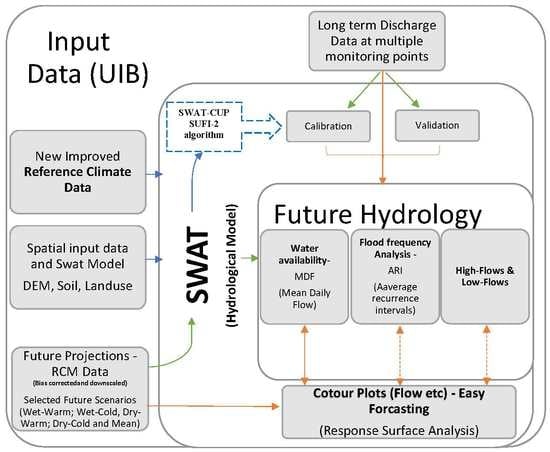Impacts of Climate Change on the Water Availability, Seasonality and Extremes in the Upper Indus Basin (UIB)
Abstract
:1. Introduction
- to minimize uncertainties in climate change hydrological impact study in the UIB by utilizing a set of improved reference climate data for the setup and calibration of the hydrological model;
- to simulate and project future flow regimes in UIB under five different climate change scenarios using the SWAT hydrological model; and
- to assess the impacts of climate change on the water availability, seasonality and extremes in the Upper Indus Basin (UIB)
2. Materials and Methods
2.1. Study Area—The Upper Indus River Basin (UIB)
2.2. Data Description
2.2.1. Reference Climate Data
2.2.2. Reference Discharge Data
2.2.3. Future Climate Forcing
2.3. Hydrological Modelling
2.3.1. SWAT Model Description
2.3.2. Spatial Input Data and SWAT Model Setup
2.3.3. Model Calibration and Validation Setup
2.4. Assessment of Changes in Future Hydrology
3. Results and Discussion
3.1. Performance of the SWAT Model (Calibration-Validation)
3.2. Future Hydrology
3.2.1. Approach
3.2.2. General Flow Characteristics
3.2.3. Response Surface Regression
3.2.4. Monthly Flows and Seasonal Shifts
3.3. Hydrological Extremes
3.3.1. Annual Return Period Flows
3.3.2. High and Low Flows
4. Conclusions
Supplementary Materials
Author Contributions
Funding
Acknowledgments
Conflicts of Interest
References
- Qin, D.; Chen, Z.; Averyt, K.B.; Miller, H.L.; Solomon, S.; Manning, M.; Marquis, M.; Tignor, M. IPCC, 2013: Summary for Policymakers. In Climate Change 2013: The Physical Science Basis. Contribution of Working Group I to the Fifth Assessment Report of the Intergovernmental Panel on Climate Change; Stocker, T.F., Qin, D., Plattner, G.-K., Tignor, M., Allen, S.K., Boschung, J., Nauels, A., Xia, Y., Bex, V., Midgley, P.M., Eds.; Cambridge University Press: Cambridge, UK; New York, NY, USA, 2013. [Google Scholar]
- Milly, P.C.D.; Dunne, K.A.; Vecchia, A.V. Global pattern of trends in streamflow and water availability in a changing climate. Nature 2005, 438, 347–350. [Google Scholar] [CrossRef] [PubMed]
- Kim, S.; Tachikawa, Y.; Nakakita, E.; Yorozu, K.; Shiiba, M. Climate change impact on river flow of the tone river basin, Japan. J. Jpn. Soc. Civ. Eng. Ser. B1 Hydraul. Eng. 2011, 67, I_85–I_90. [Google Scholar] [CrossRef] [Green Version]
- Oki, T.; Kanae, S. Global hydrological cycles and world water resources. Science 2006, 313, 1068–1072. [Google Scholar] [CrossRef] [PubMed] [Green Version]
- Abbaspour, K.C.; Faramarzi, M.; Ghasemi, S.S.; Yang, H. Assessing the impact of climate change on water resources in Iran. Water Resour. Res. 2009, 45, 413. [Google Scholar] [CrossRef] [Green Version]
- Fowler, H.J.; Kilsby, C.G.; O’Connell, P.E. Modeling the impacts of climatic change and variability on the reliability, resilience, and vulnerability of a water resource system. Water Resour. Res. 2003, 39, 39. [Google Scholar] [CrossRef] [Green Version]
- Kilroy, G. A review of the biophysical impacts of climate change in three hotspot regions in Africa and Asia. Reg. Environ. Chang. 2015, 15, 771–782. [Google Scholar] [CrossRef] [Green Version]
- Hussain, M.; Mumtaz, S. Climate change and managing water crisis: Pakistan’s perspective. Rev. Environ. Health 2014, 29, 71–77. [Google Scholar] [CrossRef]
- Hassan, Z.; Shabbir, R.; Ahmad, S.S.; Malik, A.H.; Aziz, N.; Butt, A.; Erum, S. Dynamics of land use and land cover change (LULCC) using geospatial techniques: A case study of Islamabad Pakistan. Springerplus 2016, 5, 812. [Google Scholar] [CrossRef] [Green Version]
- Khan, F.; Pilz, J.; Amjad, M.; Wiberg, D.A. Climate variability and its impacts on water resources in the Upper Indus Basin under IPCC climate change scenarios. Int. J. Glob. Warm. 2015, 8, 46. [Google Scholar] [CrossRef]
- Tahir, A.A.; Chevallier, P.; Arnaud, Y.; Ahmad, B. Snow cover dynamics and hydrological regime of the Hunza River basin, Karakoram Range, Northern Pakistan. Hydrol. Earth Syst. Sci. 2011, 15, 2275–2290. [Google Scholar] [CrossRef] [Green Version]
- Archer, D. Contrasting hydrological regimes in the upper Indus Basin. J. Hydrol. 2003, 274, 198–210. [Google Scholar] [CrossRef]
- Ali, K.F.; de Boer, D.H. Spatial patterns and variation of suspended sediment yield in the upper Indus River basin, northern Pakistan. J. Hydrol. 2007, 334, 368–387. [Google Scholar] [CrossRef]
- Immerzeel, W.W.; van Beek, L.P.H.; Bierkens, M.F.P. Climate change will affect the Asian water towers. Science 2010, 328, 1382–1385. [Google Scholar] [CrossRef] [PubMed]
- Lutz, A.F.; Immerzeel, W.W.; Kraaijenbrink, P.D.A.; Shrestha, A.B.; Bierkens, M.F.P. Climate Change Impacts on the Upper Indus Hydrology: Sources, Shifts and Extremes. PLoS ONE 2016, 11, e0165630. [Google Scholar] [CrossRef] [PubMed] [Green Version]
- Wijngaard, R.R.; Lutz, A.F.; Nepal, S.; Khanal, S.; Pradhananga, S.; Shrestha, A.B.; Immerzeel, W.W. Future changes in hydro-climatic extremes in the Upper Indus, Ganges, and Brahmaputra River basins. PLoS ONE 2017, 12, e0190224. [Google Scholar] [CrossRef] [PubMed]
- Khan, A.; Koch, M. Selecting and Downscaling a Set of Climate Models for Projecting Climatic Change for Impact Assessment in the Upper Indus Basin (UIB). Climate 2018, 6, 89. [Google Scholar] [CrossRef] [Green Version]
- Rajbhandari, R.; Shrestha, A.B.; Kulkarni, A.; Patwardhan, S.K.; Bajracharya, S.R. Projected changes in climate over the Indus river basin using a high resolution regional climate model (PRECIS). Clim. Dyn. 2015, 44, 339–357. [Google Scholar] [CrossRef] [Green Version]
- Forsythe, N.; Fowler, H.J.; Blenkinsop, S.; Burton, A.; Kilsby, C.G.; Archer, D.R.; Harpham, C.; Hashmi, M.Z. Application of a stochastic weather generator to assess climate change impacts in a semi-arid climate: The Upper Indus Basin. J. Hydrol. 2014, 517, 1019–1034. [Google Scholar] [CrossRef] [Green Version]
- Laghari, A.N.; Vanham, D.; Rauch, W. The Indus basin in the framework of current and future water resources management. Hydrol. Earth Syst. Sci. 2012, 16, 1063–1083. [Google Scholar] [CrossRef] [Green Version]
- Palazzi, E.; Filippi, L.; von Hardenberg, J. Insights into elevation-dependent warming in the Tibetan Plateau-Himalayas from CMIP5 model simulations. Clim. Dyn. 2017, 48, 3991–4008. [Google Scholar] [CrossRef] [Green Version]
- Pepin, N.; Bradley, R.S.; Diaz, H.F.; Baraer, M.; Caceres, E.B.; Forsythe, N.; Fowler, H.; Greenwood, G.; Hashmi, M.Z.; Liu, X.D.; et al. Elevation-dependent warming in mountain regions of the world. Nat. Clim. Chang. 2015, 5, 424–430. [Google Scholar] [CrossRef] [Green Version]
- Khan, S.I.; Adams, T.E. Introduction of Indus River Basin: Water Security and Sustainability. In Indus River Basin, 1st ed.; Khan, S.I., Ed.; Elsevier: Cambridge, MA, USA, 2019; pp. 3–16. ISBN 9780128127827. [Google Scholar]
- Immerzeel, W.W.; Droogers, P.; de Jong, S.M.; Bierkens, M.F.P. Large-scale monitoring of snow cover and runoff simulation in Himalayan river basins using remote sensing. Remote Sens. Environ. 2009, 113, 40–49. [Google Scholar] [CrossRef]
- ul Hasson, S. Future Water Availability from Hindukush-Karakoram-Himalaya upper Indus Basin under Conflicting Climate Change Scenarios. Climate 2016, 4, 40. [Google Scholar] [CrossRef] [Green Version]
- Bocchiola, D.; Diolaiuti, G.; Soncini, A.; Mihalcea, C.; D’Agata, C.; Mayer, C.; Lambrecht, A.; Rosso, R.; Smiraglia, C. Prediction of future hydrological regimes in poorly gauged high altitude basins: The case study of the upper Indus, Pakistan. Hydrol. Earth Syst. Sci. 2011, 15, 2059–2075. [Google Scholar] [CrossRef] [Green Version]
- Palazzi, E.; von Hardenberg, J.; Provenzale, A. Precipitation in the Hindu-Kush Karakoram Himalaya: Observations and future scenarios. J. Geophys. Res. Atmos. 2013, 118, 85–100. [Google Scholar] [CrossRef]
- Yatagai, A.; Kamiguchi, K.; Arakawa, O.; Hamada, A.; Yasutomi, N.; Kitoh, A. APHRODITE: Constructing a Long-Term Daily Gridded Precipitation Dataset for Asia Based on a Dense Network of Rain Gauges. Bull. Am. Meteorol. Soc. 2012, 93, 1401–1415. [Google Scholar] [CrossRef]
- Khan, A.; Koch, M. Correction and Informed Regionalization of Precipitation Data in a High Mountainous Region (Upper Indus Basin) and Its Effect on SWAT-Modelled Discharge. Water 2018, 10, 1557. [Google Scholar] [CrossRef] [Green Version]
- Soncini, A.; Bocchiola, D.; Confortola, G.; Bianchi, A.; Rosso, R.; Mayer, C.; Lambrecht, A.; Palazzi, E.; Smiraglia, C.; Diolaiuti, G. Future Hydrological Regimes in the Upper Indus Basin: A Case Study from a High-Altitude Glacierized Catchment. J. Hydrometeorol. 2015, 16, 306–326. [Google Scholar] [CrossRef] [Green Version]
- Akhtar, M.; Ahmad, N.; Booij, M.J. The impact of climate change on the water resources of Hindukush–Karakorum–Himalaya region under different glacier coverage scenarios. J. Hydrol. 2008, 355, 148–163. [Google Scholar] [CrossRef]
- Khan, F.; Pilz, J.; Ali, S. Improved hydrological projections and reservoir management in the Upper Indus Basin under the changing climate. Water Environ. J. 2017, 31, 235–244. [Google Scholar] [CrossRef]
- Immerzeel, W.W.; Pellicciotti, F.; Bierkens, M.F.P. Rising river flows throughout the twenty-first century in two Himalayan glacierized watersheds. Nat. Geosci. 2013, 6, 742–745. [Google Scholar] [CrossRef]
- Khan, A.J.; Koch, M. Long-Term daily gridded precipitation dataset for Upper Indus Basin (UIB) through Temporal reconstruction, Correction and informed regionalization-“ReCIR-PCP”. Water. under review.
- Bajracharya, S.R.; Shrestha, B. (Eds.) The Status of Glaciers in the Hindu Kush-Himalayan Region; International Centre for Integrated Mountain Development: Kathmandu, Nepal, 2011; ISBN 9789291152179. [Google Scholar]
- RGI Consortium. Randolph Glacier Inventory—A Dataset of Global Glacier Outlines: Version 5.0: Technical Report, Global Land Ice Measurements from Space, Version 5.0; Digital Media: Denver, CO, USA, 2015. [Google Scholar]
- Bookhagen, B.; Burbank, D.W. Topography, relief, and TRMM-derived rainfall variations along the Himalaya. Geophys. Res. Lett. 2006, 33, 21. [Google Scholar] [CrossRef] [Green Version]
- Ali, S.; Li, D.; Congbin, F.; Khan, F. Twenty first century climatic and hydrological changes over Upper Indus Basin of Himalayan region of Pakistan. Environ. Res. Lett. 2015, 10, 14007. [Google Scholar] [CrossRef]
- Hewitt, K. Glacier Change, Concentration, and Elevation Effects in the Karakoram Himalaya, Upper Indus Basin. Mt. Res. Dev. 2011, 31, 188–200. [Google Scholar] [CrossRef]
- Wake, C.P. Glaciochemical Investigations as a Tool for Determining the Spatial and Seasonal Variation of Snow Accumulation in the Central Karakoram, Northern Pakistan. Ann. Glaciol. 1989, 13, 279–284. [Google Scholar] [CrossRef] [Green Version]
- Karim, A.; Veizer, J. Water balance of the Indus River Basin and moisture source in the Karakoram and western Himalayas: Implications from hydrogen and oxygen isotopes in river water. J. Geophys. Res. 2002, 107, 190. [Google Scholar] [CrossRef]
- Khan, A.; Koch, M.; Chinchilla, K. Evaluation of Gridded Multi-Satellite Precipitation Estimation (TRMM-3B42-V7) Performance in the Upper Indus Basin (UIB). Climate 2018, 6, 76. [Google Scholar] [CrossRef] [Green Version]
- Hasson, S.; Böhner, J.; Lucarini, V. Prevailing climatic trends and runoff response from Hindukush–Karakoram–Himalaya, upper Indus Basin. Earth Syst. Dyn. 2017, 8, 337–355. [Google Scholar] [CrossRef] [Green Version]
- Khattak, M.S.; Babel, M.S.; Sharif, M. Hydro-meteorological trends in the upper Indus River basin in Pakistan. Clim. Res. 2011, 46, 103–119. [Google Scholar] [CrossRef]
- Amin, A.; Iqbal, J.; Asghar, A.; Ribbe, L. Analysis of Current and Future Water Demands in the Upper Indus Basin under IPCC Climate and Socio-Economic Scenarios Using a Hydro-Economic WEAP Model. Water 2018, 10, 537. [Google Scholar] [CrossRef] [Green Version]
- Teutschbein, C.; Seibert, J. Bias correction of regional climate model simulations for hydrological climate-change impact studies: Review and evaluation of different methods. J. Hydrol. 2012, 456, 12–29. [Google Scholar] [CrossRef]
- Giorgi, F.; Coppola, E.; Solmon, F.; Mariotti, L.; Sylla, M.B.; Bi, X.; Elguindi, N.; Diro, G.T.; Nair, V.; Giuliani, G.; et al. RegCM4: Model description and preliminary tests over multiple CORDEX domains. Clim. Res. 2012, 52, 7–29. [Google Scholar] [CrossRef] [Green Version]
- Samuelsson, P.; Jones, C.G.; Will’En, U.; Ullerstig, A.; Gollvik, S.; Hansson, U.; Jansson, E.; Kjellstro¨M, C.; Nikulin, G.; Wyser, K. The Rossby Centre Regional Climate model RCA3: Model description and performance. Tellus A Dyn. Meteorol. Oceanogr. 2011, 63, 4–23. [Google Scholar] [CrossRef] [Green Version]
- Arnold, J.G.; Srinivasan, R.; Muttiah, R.S.; Williams, J.R. Large area hydrologic modeling and assessment part i: Model development. J. Am. Water Resour. Assoc. 1998, 34, 73–89. [Google Scholar] [CrossRef]
- Srinivasan, R.; Ramanarayanan, T.S.; Arnold, J.G.; Bednarz, S.T. Large area hydrologic modeling and assessment part ii: Model application. J. Am. Water Resour. Assoc. 1998, 34, 91–101. [Google Scholar] [CrossRef]
- Cherie, N.; Koch, M. (Eds.) Mono- and multi-Model statistical Downscaling of GCM—Climate Predictors for the Upper Blue Nile River Basin, Ethiopia. In Proceedings of the 6th International Conference on Water Resources and Enviromental Research (ICWRER), Koblenz, Germany, 3–7 June 2013. [Google Scholar]
- Fereidoon, M.; Koch, M. SWAT-MODSIM-PSO optimization of multi-crop planning in the Karkheh River Basin, Iran, under the impacts of climate change. Sci. Total Environ. 2018, 630, 502–516. [Google Scholar] [CrossRef]
- Kundu, S.; Khare, D.; Mondal, A. Individual and combined impacts of future climate and land use changes on the water balance. Ecol. Eng. 2017, 105, 42–57. [Google Scholar] [CrossRef]
- Neitsch, S.L.; Arnold, J.G.; Kiniry, J.R.; Williams, J.R. Soil and Water Assessment Tool, Theoretical Documentation, Version 2009; Texas Water Resources Institute Technical Report No. 406. Available online: https://swat.tamu.edu/media/99192/swat2009-theory.pdf (accessed on 9 February 2020).
- Lehner, B.; Verdin, K.; Jarvis, A. New Global Hydrography Derived From Spaceborne Elevation Data. Eos Trans. Am. Geophys. Union 2008, 89, 93–94. [Google Scholar] [CrossRef]
- Farr, T.G.; Rosen, P.A.; Caro, E.; Crippen, R.; Duren, R.; Hensley, S.; Kobrick, M.; Paller, M.; Rodriguez, E.; Roth, L.; et al. The Shuttle Radar Topography Mission. Rev. Geophys. 2007, 45, 1485. [Google Scholar] [CrossRef] [Green Version]
- FAO-UNESCO. FAO-UNESCO Soil Map of the World, Version 3.6; Food and Agriculture Organization of the United Nations. FAO GEONETWORK: Rome, Italy, 2007. [Google Scholar]
- USGS EROS Data Center. GLCC—Global Land Cover Characteristics Data Base, Version 2.0; USGS, Earth Resources Observation and Science (EROS) Center: Garretson, SD, USA, 2002.
- Abbaspour, K.C. SWAT Calibration and Uncertainty Program—A User Manual; Swiss Federal Institute of Aquatic Science and Technology: Eawag, Switzerland, 2015. [Google Scholar]
- Abbaspour, K.C.; Yang, J.; Maximov, I.; Siber, R.; Bogner, K.; Mieleitner, J.; Zobrist, J.; Srinivasan, R. Modelling hydrology and water quality in the pre-alpine/alpine Thur watershed using SWAT. J. Hydrol. 2007, 333, 413–430. [Google Scholar] [CrossRef]
- Schuol, J.; Abbaspour, K.C.; Srinivasan, R.; Yang, H. Estimation of freshwater availability in the West African sub-continent using the SWAT hydrologic model. J. Hydrol. 2008, 352, 30–49. [Google Scholar] [CrossRef]
- Yang, J.; Reichert, P.; Abbaspour, K.C.; Xia, J.; Yang, H. Comparing uncertainty analysis techniques for a SWAT application to the Chaohe Basin in China. J. Hydrol. 2008, 358, 1–23. [Google Scholar] [CrossRef]
- Mark, B.G.; Seltzer, G.O. Tropical glacier meltwater contribution to stream discharge: A case study in the Cordillera Blanca, Peru. J. Glaciol. 2003, 49, 271–281. [Google Scholar] [CrossRef] [Green Version]
- Yu, J.; Qin, X.; Larsen, O.; Chua, L.H.C. Comparison between Response Surface Models and Artificial Neural Networks in Hydrologic Forecasting. J. Hydrol. Eng. 2014, 19, 473–481. [Google Scholar] [CrossRef]
- Carley, K.M.; Kamneva, N.Y.; Reminga, J. Response Surface Methodology: CASOS Technical Report; Carnegie Mellon University, Institute for Software Research International: Pittsburgh, PA, USA, 2004; CMU-ISR-04-136. [Google Scholar]
- Keshtegar, B.; Allawi, M.F.; Afan, H.A.; El-Shafie, A. Optimized River Stream-Flow Forecasting Model Utilizing High-Order Response Surface Method. Water Resour. Manag. 2016, 30, 3899–3914. [Google Scholar] [CrossRef]
- Chow, V.T.; Maidment, D.R.; Mays, L.W. Applied Hydrology; Tata McGraw-Hill, Ed.; Tata McGraw-Hill Education: New Delhi, NY, USA, 2010; ISBN 007070242X. [Google Scholar]


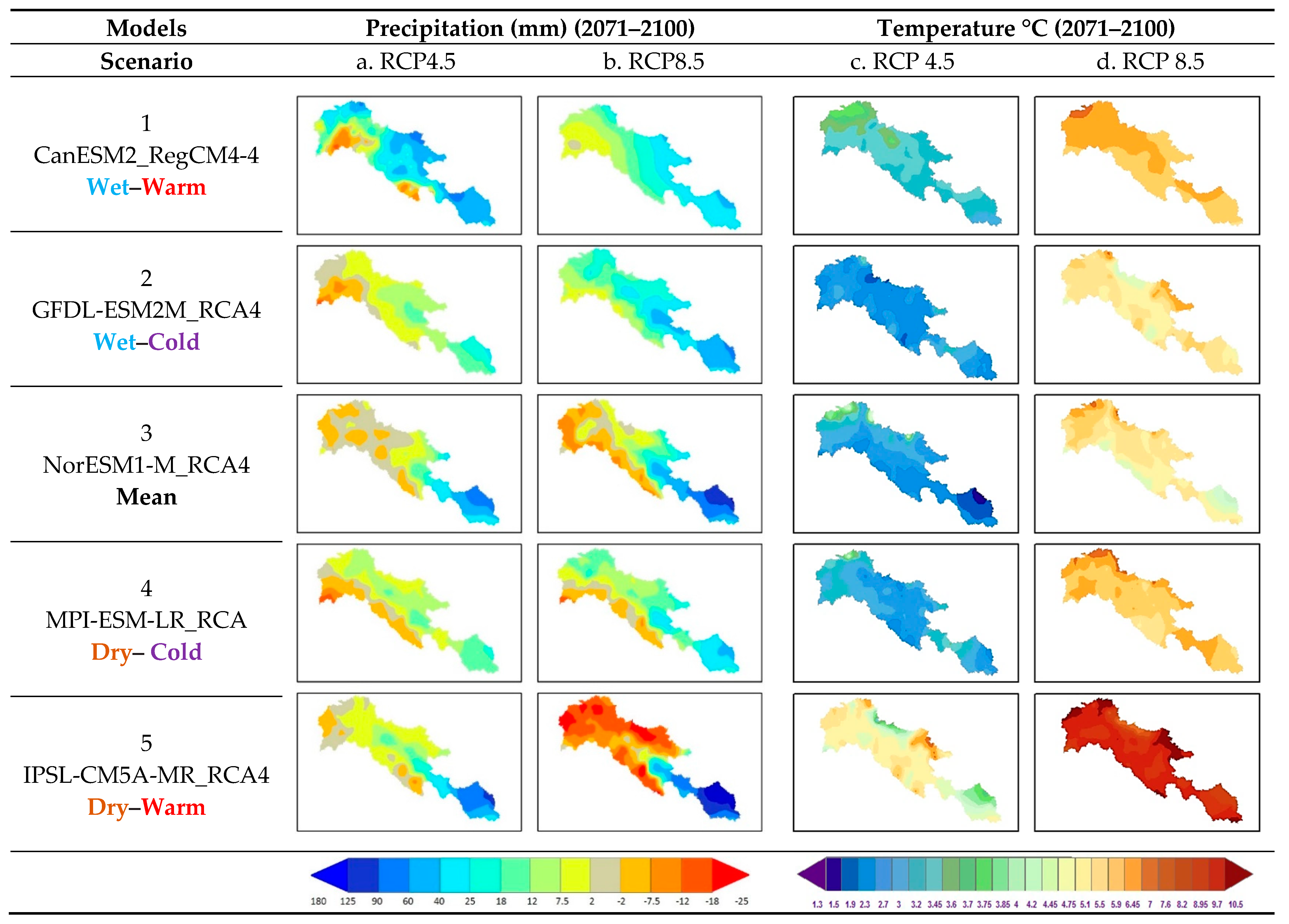
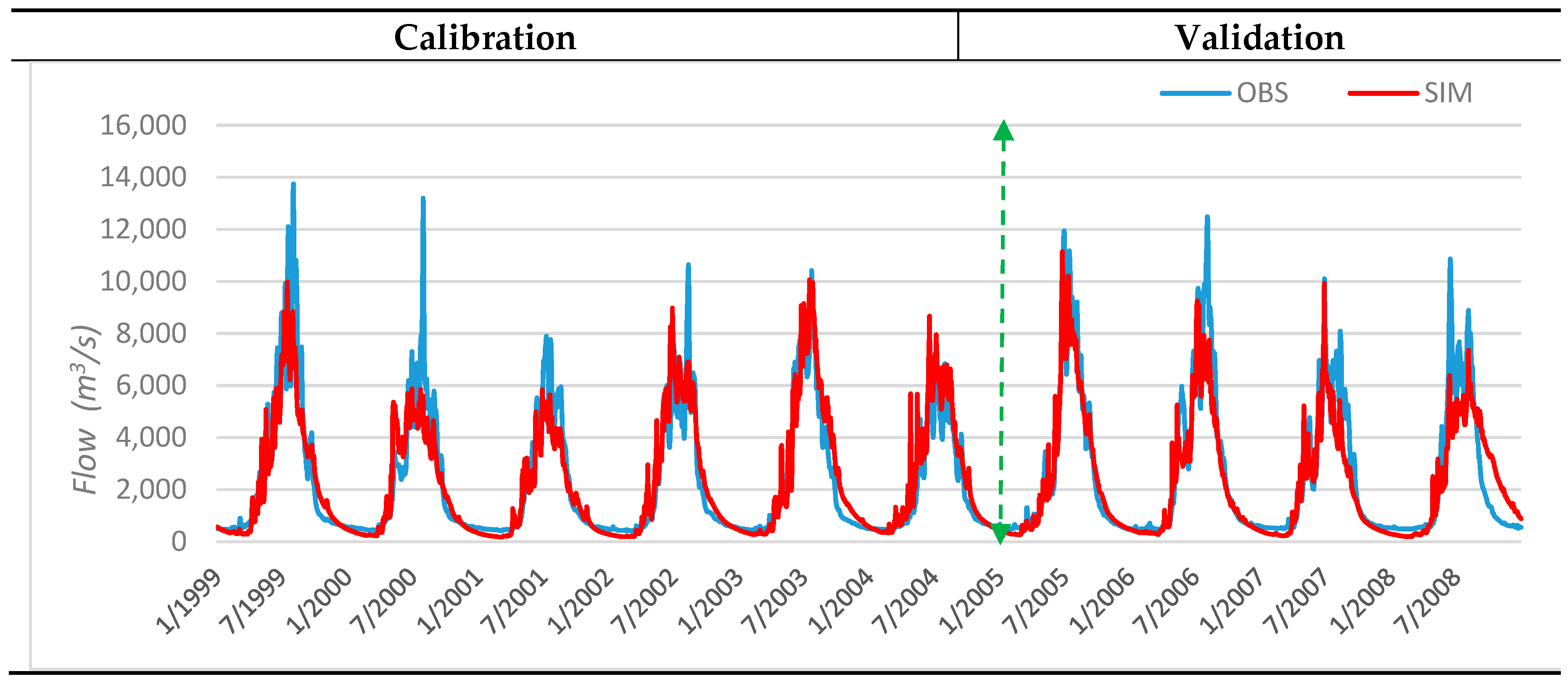

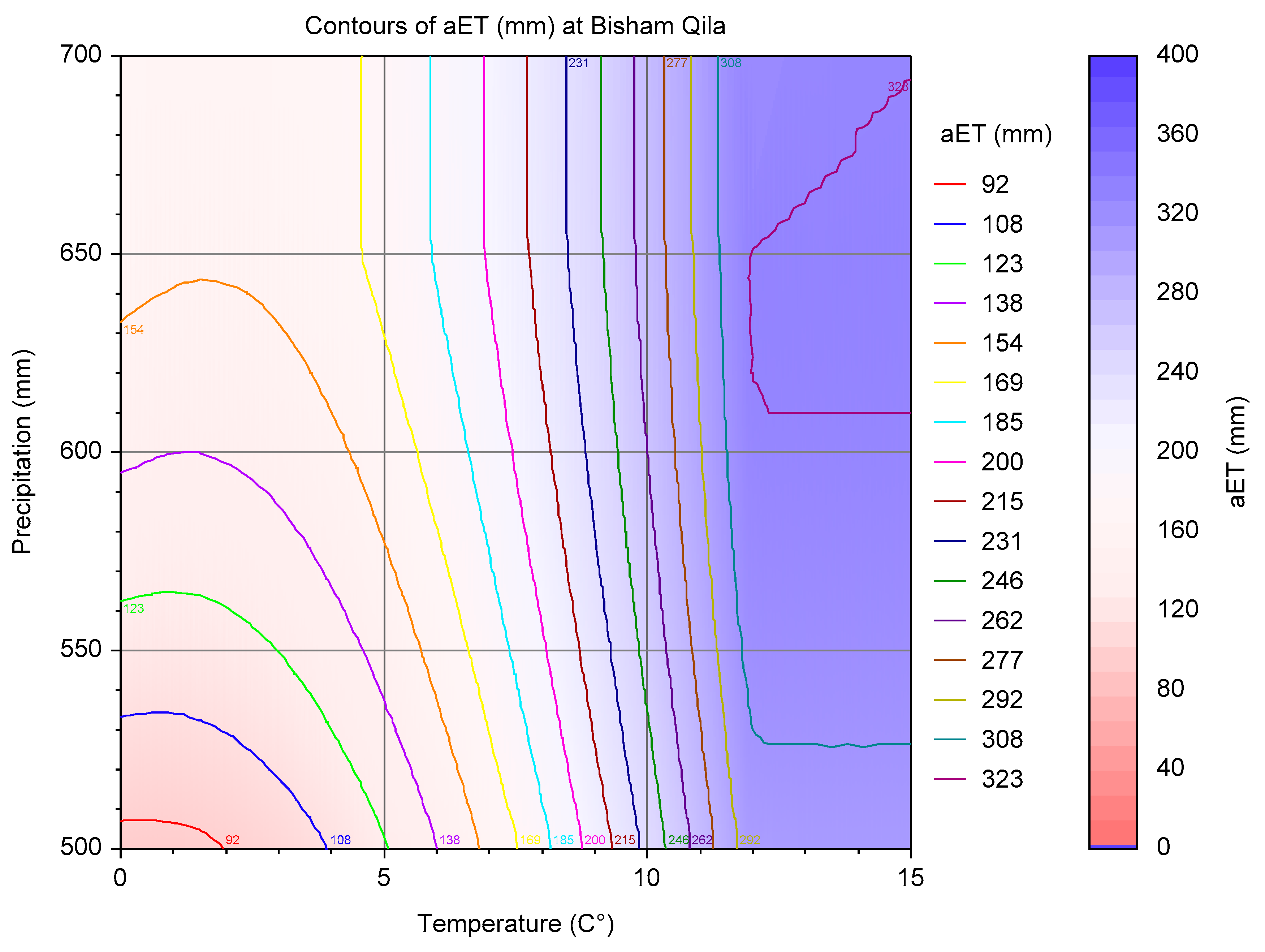

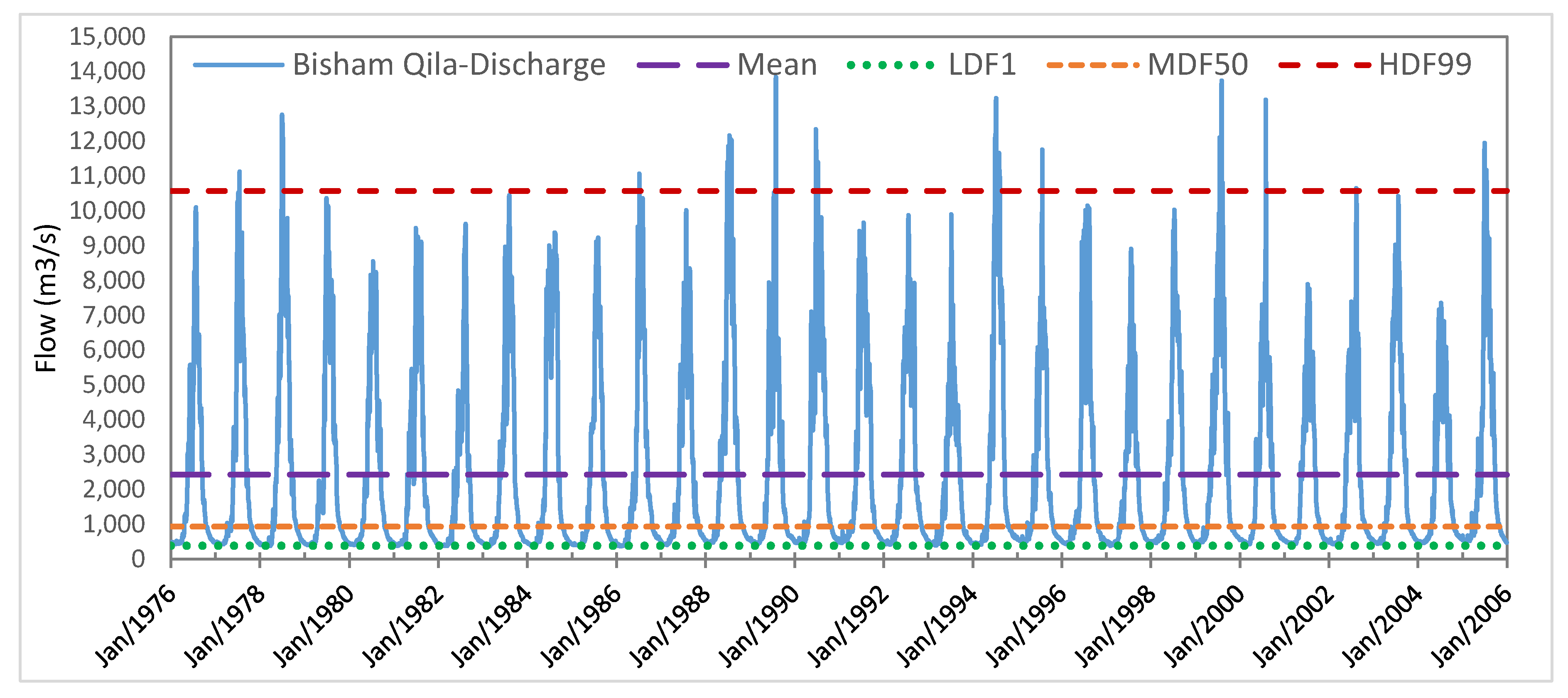
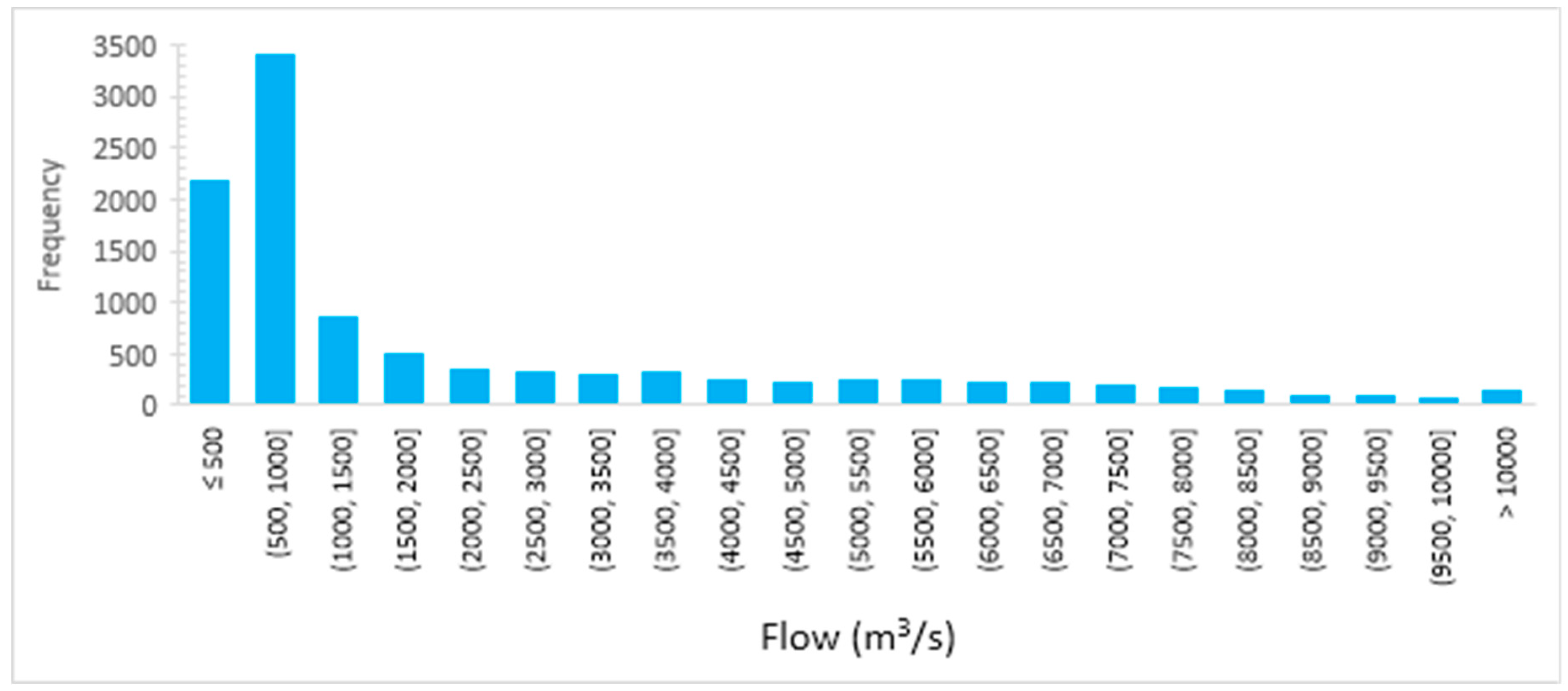


| Serial No. | River/ Tributary | Station Name | Area (km2) | Mean Discharge (m3/s) | Elevation (m.a.s.l) | Duration (years) |
|---|---|---|---|---|---|---|
| 1 | Astore River | Doyan | 3906.15 | 138 | 1580 | 1974–2010 |
| 2 | Gilgit River | Gilgit | 12,777.89 | 303 | 1430 | 1970–2010 |
| 3 | Hunza River | Dainyor | 13,761.15 | 294 | 1420 | 1966–2010 |
| 4 | Shigar River | Shigar | 6934.22 | 230 | 2220 | 1985–1998 and 2001 |
| 5 | Shyok River | Yugo | 32,934.58 | 410 | 2460 | 1974–2010 |
| 6 | Indus River | Besham Qila | 165,610.93 | 2425 | 600 | 1969–2010 |
| 7 | Indus River | Shatial | 156,125.15 | 2222 | 980 | 1998–2007 |
| 8 | Indus River | Kachura | 113,744.60 | 1151 | 2180 | 1970–2010 |
| 9 | Indus River | Kharmong | 3906.15 | 460 | 2500 | 1982–2010 |
| No | Scenario 1 | Experiment Name 2–Short 3 Form | Driving GCM | RCM | RCM Description | |
|---|---|---|---|---|---|---|
| 1 | Wet-Warm | CanESM2_RegCM4-4 | CAN | CCCma-CanESM2 | RegCM4 | Abdus Salam International Centre for Theoretical Physics (ICTP) Regional Climatic Model version 4 (RegCM4; [47]) |
| 2 | Wet-Cold | GFDL-ESM2M_RCA4 | GFDL | NOAA-GFDL-GFDL-ESM2M | RCA4 | Rossby Centre regional atmospheric model version 4 (RCA4; [48]) |
| 3 | Mean | NorESM1-M_RCA4 | NOR | Nor-ESM1-M | ||
| 4 | Dry-Cold | MPI-ESM-LR_RCA4 | MPI | MPI-ESM-LR | ||
| 5 | Dry-Warm | IPSL-CM5A-MR_RCA4 | IPSL | IPSL-CM5A-MR | ||
| Model | Period | Precipitation (mm) | Temperature (C°) | ||||||||||||
|---|---|---|---|---|---|---|---|---|---|---|---|---|---|---|---|
| RCP 4.5 Values and (change %) | RCP 8.5 Values and (change %) | RCP 4.5 Values and (change) | RCP 8.5 Values and (change) | ||||||||||||
| PCP (mm) (Av-An) | 90th Percentile (mm) | Probability-Wet Days (days) | Intensity-Wet Days (mm) | PCP (mm) (Av-An) | 90th Percentile (mm) | Probability-Wet Days (days) | Intensity-Wet Days (mm) | TMP (C°) (mean) | 90th Percentile (C°) | 10th Percentile (C°) | TMP (C°) (mean) | 90th Percentile (C°) | 10th Percentile (C°) | ||
| IPSL-CM5A-MR_ RCA4 | 41–70 | 539 (2.9%) | 19.7 (36.8%) | 107.4 (−7.8%) | 5.0 (13.2%) | 532 (1.7%) | 19.5 (35.4%) | 106.9 (−8.3%) | 4.9 (11.8%) | 5.52 (4.12) | 17.6 (3.85) | −6.1 (4.93) | 6.3 (4.91) | 18.4 (4.66) | −5.3 (5.70) |
| 71–00 | 557 (6.2%) | 20.7 (42.1%) | 107.4 (−7.8%) | 5.2 (17%) | 502 (−4.2%) | 20.5 (18%) | 94.4 (−1.9%) | 5.4 (22%) | 7.7 (6.33) | 19.1 (5.34) | −3.6 (7.44) | 10.4 (9.0) | 21.9 (8.17) | −1.2 (9.82) | |
| MPI-ESM-LR_ RCA4 | 41–70 | 536 (2.3%) | 18.6 (29.1%) | 110.9 (−4.8%) | 4.6 (5.2%) | 535 (2.0%) | 18.6 (29.1%) | 108.5 (−6.9%) | 4.7 (7.3%) | 4.0 (2.64) | 16.2 (2.44) | −8.1 (2.85) | 4.5 (3.08) | 16.7 (2.99) | −7.7 (3.27) |
| 71–00 | 537 (2.4%) | 18.7 (41.1%) | 109.1 (−6.4%) | 4.7 (7.7%) | 559 (6.7%) | 20.3 (41.1%) | 106.1 (−8.9%) | 5.1 (15.5%) | 5.5 (4.11) | 17.4 (3.67) | −6.5 (4.48) | 7.3 (5.86) | 19.2 (5.51) | −4.9 (6.09) | |
| NorESM1-M_ RCA4 | 41–70 | 536 (2.4%) | 20.3 (46.1%) | 109.0 (−6.4%) | 4.9 (10.7%) | 555 (6.0%) | 21.1 (46.1%) | 111.3 (−4.5%) | 4.9 (12.3%) | 3.8 (2.36) | 16.8 (3.03) | −8.0 (3.02) | 4.3 (2.92) | 17.9 (4.2) | −7.5 (3.53) |
| 71–00 | 537 (2.5%) | 20.3 (54.4%) | 109.0 (−6.4%) | 4.9 (12%) | 548 (4.6%) | 22.2 (54.4%) | 107.0 (−8.2%) | 5.2 (17.5%) | 4.9 (3.50) | 17.7 (3.99) | −6.76 (4.23) | 6.6 (5.23) | 19.9 (6.16) | −5.1 (5.93) | |
| GFDL-ESM2M_ RCA4 | 41–70 | 540 (3.1%) | 17.9 (42.6%) | 111.9 (−4%) | 4.7 (7%) | 578 (10.4%) | 20.5 (42.6%) | 114.9 (−1.4%) | 4.9 (11.1%) | 3.8 (2.41) | 16.0 (2.31) | −7.8 (3.22) | 4.1 (2.73) | 16.2 (2.43) | −7.0 (4.02) |
| 71–00 | 536 (2.2%) | 19.4 (52.8%) | 112.8 (−3.2%) | 4.7 (5.7%) | 612 (16.8%) | 22.0 (52.8%) | 114.7 (−1.5%) | 5.2 (18.6%) | 5.1 (3.70) | 17.14 (3.42) | −6.4 (4.57) | 6.6 (5.22) | 18.8 (5.03) | −4.8 (6.17) | |
| CanESM2_ RegCM4-4 | 41–70 | 560 (6.9%) | 21.1 (43.8%) | 119.6 (2.7%) | 4.7 (6.4%) | 557 (6.3%) | 20.7 (43.8%) | 115.6 (−0.8%) | 4.6 (5.5%) | 4.5 (3.14) | 16.8 (3.08) | −7.8 (3.20) | 4.9 (3.51) | 16.9 (3.16) | −7.2 (3.75) |
| 71–00 | 607 (15.9%) | 23.2 (51.6%) | 117.2 (0.6%) | 5.05 (14.8%) | 590 (12.5%) | 21.8 (51.6%) | 114.9 (−1.3%) | 5.0 (13.2%) | 5.6 (4.24) | 17.5 (3.8) | −6.5 (4.47) | 7.4 (6.03) | 20.0 (6.24) | −5.1 (5.89) | |
| Observed | 1976–2005 | 524 | 14.4 | 116.5 | 4.4 | 524.1 | 14.4 | 116.5 | 4.4 | 1.4 | 13.7 | −11.0 | 1.4 | 13.7 | −11.0 |
| Gauge Station (River) | R2 | NS | PBIAS | KGE | Mean_sim (Mean_obs) (m3/s) | P-Factor | R-Factor |
|---|---|---|---|---|---|---|---|
| Gilgit (Gilgit) | 0.77 | 0.76 | −12.80 | 0.81 | 341.83 (303.13) | 0.71 | 0.65 |
| Dainor (Hunza) | 0.88 | 0.86 | −0.50 | 0.89 | 304.55 (303.09) | 0.50 | 0.34 |
| Doyan (Astor) | 0.77 | 0.76 | 12.40 | 0.80 | 120.77 (137.83) | 0.68 | 0.49 |
| Shigar (Shigar) | 0.75 | 0.73 | 2.3 | 0.86 | 224.63 (229.93) | 0.50 | 0.82 |
| Yugo (Shyok) | 0.69 | 0.69 | −5.60 | 0.79 | 433.67 (410.80) | 0.70 | 0.65 |
| Kharmong (Indus) | 0.75 | 0.70 | 19.70 | 0.70 | 336.99 (419.87) | 0.75 | 1.00 |
| Kachura (Indus) | 0.78 | 0.78 | 5.10 | 0.82 | 1092.04 (1151.04) | 0.63 | 0.50 |
| Shatyal (Indus) | 0.89 | 0.89 | 3.10 | 0.88 | 2153.49 (2222.91) | 0.68 | 0.34 |
| Bisham Qila (Indus) | 0.86 | 0.85 | 4.70 | 0.85 | 2320.87 (2436.47) | 0.58 | 0.34 |
| RCP | Time Period | Flow | MDF 2 (m3/s) | LDF1 *(m3/s) | HDF99 ** (m3/s) | MDF 7 (mm) | aET 3 (mm) | Prec 4 (mm) | Tmp 5 (°C) | ΔGm 6 (mm) | |||||
|---|---|---|---|---|---|---|---|---|---|---|---|---|---|---|---|
| Reference→ | 2320 | 385 | 10,540 | 442 | 115 | 524 | 1.40 | Estimated Value | |||||||
| Model 1↓ | Value | % Change | Value | % Change | Value | % Change | Value | Change(mm) | Value | Change(mm) | Change(mm) | Change(°C) | Change(mm) | ||
| RCP 4.5 | 2041–2070 | CAN | 2635 | 13.6 | 215 | −44 | 11642 | 10 | 502 | 60 | 162 | 47 | 36 | 3.14 | 71 |
| GFDL | 2866 | 23.5 | 205 | −47 | 14013 | 33 | 546 | 104 | 115 | 0 | 16 | 2.41 | 88 | ||
| IPSL | 2540 | 9.5 | 241 | −37 | 11142 | 6 | 484 | 42 | 161 | 46 | 15 | 4.2 | 73 | ||
| MPI | 2888 | 24.5 | 216 | −44 | 13383 | 27 | 550 | 108 | 117 | 2 | 12 | 2.64 | 98 | ||
| NOR | 3002 | 29.4 | 224 | −42 | 14092 | 34 | 572 | 130 | 105 | −10 | 12 | 2.36 | 108 | ||
| 2071–2100 | CAN | 2762 | 19.1 | 243 | −37 | 12570 | 19 | 526 | 84 | 181 | 66 | 83 | 4.24 | 67 | |
| GFDL | 2722 | 17.3 | 172 | −55 | 13040 | 24 | 519 | 77 | 126 | 11 | 12 | 3.7 | 76 | ||
| IPSL | 2556 | 10.2 | 233 | −39 | 11943 | 13 | 487 | 45 | 174 | 59 | 33 | 6.33 | 71 | ||
| MPI | 2759 | 18.9 | 202 | −48 | 13610 | 29 | 526 | 84 | 137 | 22 | 13 | 4.11 | 93 | ||
| NOR | 2759 | 18.9 | 220 | −43 | 12330 | 17 | 526 | 84 | 123 | 8 | 13 | 3.5 | 79 | ||
| RCP 8.5 | 2041–2070 | CAN | 2690 | 15.9 | 240 | −38 | 11850 | 12 | 513 | 71 | 183 | 68 | 33 | 3.51 | 106 |
| GFDL | 3010 | 29.7 | 212 | −45 | 15711 | 49 | 574 | 132 | 135 | 20 | 54 | 2.73 | 98 | ||
| IPSL | 2273 | −2.0 | 236 | −39 | 10138 | −4 | 433 | −9 | 196 | 81 | 8 | 4.91 | 64 | ||
| MPI | 2802 | 20.8 | 227 | −41 | 12739 | 21 | 534 | 92 | 131 | 16 | 11 | 3.08 | 97 | ||
| NOR | 3001 | 29.4 | 208 | −46 | 14264 | 35 | 572 | 130 | 119 | 4 | 31 | 2.92 | 103 | ||
| 2071–2100 | CAN | 2528 | 9.0 | 231 | −40 | 11944 | 13 | 482 | 40 | 219 | 104 | 66 | 6.03 | 78 | |
| GFDL | 2957 | 27.5 | 231 | −40 | 13884 | 32 | 563 | 121 | 170 | 55 | 88 | 5.22 | 88 | ||
| IPSL | 1685 | −27.4 | 172 | −55 | 8329 | −21 | 321 | −121 | 247 | 132 | −22 | 9.0 | 33 | ||
| MPI | 2715 | 17.0 | 212 | −45 | 12950 | 23 | 517 | 75 | 170 | 55 | 35 | 5.86 | 95 | ||
| NOR | 2594 | 11.8 | 206 | −46 | 13044 | 24 | 494 | 52 | 169 | 54 | 24 | 5.23 | 82 | ||
| RCP | Time Period | Flow | 10Yr RI 3 | 15Yr RI 4 | 30Yr RI 5 | |||
|---|---|---|---|---|---|---|---|---|
| Reference 1→ | 12,837 | 13,260 | 13,863 | |||||
| Model 2↓ | Value (m3/s) | % Change | Value (m3/s) | % Change | Value (m3/s) | % Change | ||
| RCP 4.5 | 2041–2070 | CAN | 19,229 | 49.8 | 20,042 | 51.1 | 21,146 | 52.5 |
| GFDL | 25,019 | 94.9 | 26,874 | 102.7 | 29,681 | 114.1 | ||
| IPSL | 21,254 | 65.6 | 22,584 | 70.3 | 24,473 | 76.5 | ||
| MPI | 23,042 | 79.5 | 24,504 | 84.8 | 26,680 | 92.5 | ||
| NOR | 19,644 | 53.0 | 20,356 | 53.5 | 21,335 | 53.9 | ||
| 2071–2100 | CAN | 21,616 | 68.4 | 23,009 | 73.5 | 25,110 | 81.1 | |
| GFDL | 24,120 | 87.9 | 25,848 | 94.9 | 28,335 | 104.4 | ||
| IPSL | 21,711 | 69.1 | 22,995 | 73.4 | 24,865 | 79.4 | ||
| MPI | 23,698 | 84.6 | 25,722 | 94.0 | 28,942 | 108.8 | ||
| NOR | 20,114 | 56.7 | 21,474 | 61.9 | 23,496 | 69.5 | ||
| RCP 8.5 | 2041–2070 | CAN | 22,183 | 72.8 | 23,596 | 77.9 | 25,780 | 86.0 |
| GFDL | 26,998 | 110.3 | 28,897 | 117.9 | 31,713 | 128.8 | ||
| IPSL | 20,709 | 61.3 | 22,318 | 68.3 | 24,842 | 79.2 | ||
| MPI | 21,655 | 68.7 | 22,749 | 71.6 | 24,289 | 75.2 | ||
| NOR | 23,351 | 81.9 | 24,704 | 86.3 | 26,619 | 92.0 | ||
| 2071–2100 | CAN | 24,073 | 87.5 | 25,708 | 93.9 | 28,174 | 103.2 | |
| GFDL | 26,178 | 103.9 | 28,012 | 111.3 | 30,698 | 121.4 | ||
| IPSL | 25,740 | 100.5 | 28,550 | 115.3 | 32,840 | 136.9 | ||
| MPI | 26,507 | 106.5 | 28,597 | 115.7 | 31,691 | 128.6 | ||
| NOR | 23,840 | 85.7 | 25,879 | 95.2 | 29,057 | 109.6 | ||
| High-Flow Spells | Low-Flow Spells | |||||||||||||||||
|---|---|---|---|---|---|---|---|---|---|---|---|---|---|---|---|---|---|---|
| RCP | Duration | Flow | HSNum 3 | HSLong 4 | HSMeanDur 5 | MHSPeaks 6 | LSNum 7 | LSLong 8 | LSMeanDur 9 | MLSTrough 10 | ||||||||
| Reference 1→ | 23 | 12 | 4.7 | 11,963 | 16 | 21 | 7 | 376 | ||||||||||
| Model 2↓ | Value | % change | Value | % change | Value | % change | Value | % change | Value | % change | Value | % change | Value | % change | Value | % change | ||
| RCP 4.5 | 2041–2070 | CAN | 100 | 335 | 12 | 0 | 2 | −59 | 12,859 | 7 | 139 | 769 | 75 | 257 | 11 | 51 | 315 | −16 |
| GFDL | 108 | 370 | 47 | 292 | 4 | −25 | 14,130 | 18 | 109 | 581 | 109 | 419 | 15 | 112 | 311 | −17 | ||
| IPSL | 82 | 257 | 5 | −58 | 2 | −63 | 13,510 | 13 | 119 | 644 | 79 | 276 | 8 | 21 | 323 | −14 | ||
| MPI | 110 | 378 | 42 | 250 | 3 | −34 | 13,596 | 14 | 95 | 494 | 95 | 352 | 16 | 127 | 312 | −17 | ||
| NOR | 108 | 370 | 59 | 392 | 4 | −24 | 13,439 | 12 | 100 | 525 | 81 | 286 | 15 | 109 | 320 | −15 | ||
| 2071–2100 | CAN | 97 | 322 | 21 | 75 | 3 | −42 | 13,683 | 14 | 134 | 738 | 53 | 152 | 9 | 27 | 320 | −15 | |
| GFDL | 102 | 343 | 29 | 142 | 4 | −24 | 13,813 | 15 | 114 | 613 | 120 | 471 | 16 | 128 | 309 | −18 | ||
| IPSL | 77 | 235 | 10 | −17 | 2 | −53 | 14,242 | 19 | 100 | 525 | 70 | 233 | 10 | 49 | 317 | −16 | ||
| MPI | 100 | 335 | 36 | 200 | 3 | −27 | 13,941 | 17 | 116 | 625 | 132 | 529 | 15 | 111 | 311 | −17 | ||
| NOR | 80 | 248 | 22 | 83 | 3 | −33 | 13,421 | 12 | 137 | 756 | 97 | 362 | 12 | 72 | 325 | −14 | ||
| RCP 8.5 | 2041–2070 | CAN | 101 | 339 | 16 | 33 | 2 | −57 | 13,677 | 14 | 138 | 763 | 69 | 229 | 8 | 11 | 325 | −14 |
| GFDL | 106 | 361 | 75 | 525 | 4 | −15 | 14,746 | 23 | 105 | 556 | 81 | 286 | 12 | 67 | 315 | −16 | ||
| IPSL | 60 | 161 | 8 | −33 | 1 | −69 | 13,612 | 14 | 119 | 644 | 73 | 248 | 8 | 17 | 326 | −13 | ||
| MPI | 106 | 361 | 37 | 208 | 3 | −34 | 13,663 | 14 | 109 | 581 | 112 | 433 | 12 | 76 | 313 | −17 | ||
| NOR | 116 | 404 | 70 | 483 | 3 | −29 | 13,520 | 13 | 91 | 469 | 88 | 319 | 12 | 77 | 319 | −15 | ||
| 2071–2100 | CAN | 94 | 309 | 12 | 0 | 2 | −58 | 14,447 | 21 | 115 | 619 | 53 | 152 | 9 | 30 | 316 | −16 | |
| GFDL | 109 | 374 | 29 | 142 | 3 | −37 | 14,289 | 19 | 96 | 500 | 96 | 357 | 10 | 49 | 329 | −13 | ||
| IPSL | 30 | 30 | 3 | −75 | 1 | −70 | 16,594 | 39 | 97 | 506 | 136 | 548 | 14 | 102 | 304 | −19 | ||
| MPI | 105 | 357 | 46 | 283 | 3 | −33 | 13,966 | 17 | 96 | 500 | 93 | 343 | 12 | 70 | 319 | −15 | ||
| NOR | 84 | 265 | 67 | 458 | 3 | −44 | 13,970 | 17 | 93 | 481 | 83 | 295 | 16 | 132 | 316 | −16 | ||
© 2020 by the authors. Licensee MDPI, Basel, Switzerland. This article is an open access article distributed under the terms and conditions of the Creative Commons Attribution (CC BY) license (http://creativecommons.org/licenses/by/4.0/).
Share and Cite
Khan, A.J.; Koch, M.; Tahir, A.A. Impacts of Climate Change on the Water Availability, Seasonality and Extremes in the Upper Indus Basin (UIB). Sustainability 2020, 12, 1283. https://doi.org/10.3390/su12041283
Khan AJ, Koch M, Tahir AA. Impacts of Climate Change on the Water Availability, Seasonality and Extremes in the Upper Indus Basin (UIB). Sustainability. 2020; 12(4):1283. https://doi.org/10.3390/su12041283
Chicago/Turabian StyleKhan, Asim Jahangir, Manfred Koch, and Adnan Ahmad Tahir. 2020. "Impacts of Climate Change on the Water Availability, Seasonality and Extremes in the Upper Indus Basin (UIB)" Sustainability 12, no. 4: 1283. https://doi.org/10.3390/su12041283
APA StyleKhan, A. J., Koch, M., & Tahir, A. A. (2020). Impacts of Climate Change on the Water Availability, Seasonality and Extremes in the Upper Indus Basin (UIB). Sustainability, 12(4), 1283. https://doi.org/10.3390/su12041283




